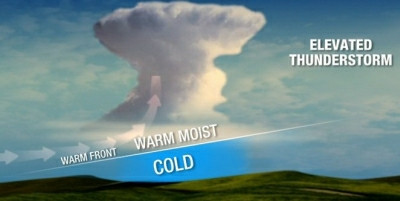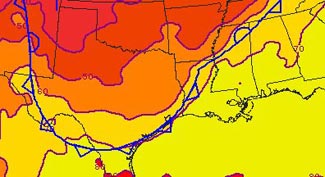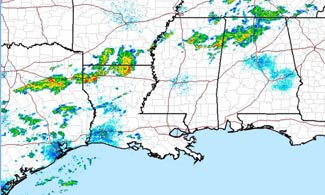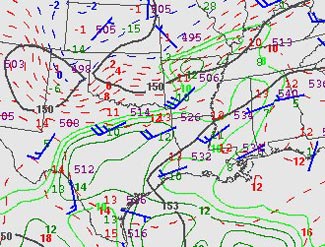| ELEVATED CONVECTION |
theweatherprediction.com

Notice that the Skew-T's on the web always have the parcel lapse rate beginning from the surface. This is not always the case in the real troposphere especially in the cool season. After a cold front passes, parcels of air no longer lift from the surface (remember that cold air is dense and resists upward motion more so than warm air). Rain that occurs behind a cold front or on the cool side of a warm front is not a result of parcels rising from the surface but by rather "elevated convection". Elevated convection is the convective lifting of air that initially begins to rise starting above the planetary boundary layer. When a front is involved (cold, warm, dryline) the parcels lift from the top of the front. On a sounding, a temperature inversion often marks the vertical depth of the front. Wind and dewpoint changes in the vertical can also help locate the vertical frontal boundary.
Parcels generally rise from the surface on days with air mass thunderstorms, upslope convection and rain/thunderstorms in the warm sector of a mid-latitude cyclone. Parcels of air do NOT necessarily rise from the surface when uplift mechanisms such as vorticity, jet streaks, isentropic lifting or frontal lifting is involved.
Why is this important? Because many of the indices (CAPE, LI, and others) assume parcels of air begin to rise from the surface. In a situation where "elevated convection" occurs, the convective surface will be higher in the troposphere and often just above an inversion, as mentioned earlier. Sounding software is required in order to have the parcel rise from the point you want on the Skew-T and calculate the indices. Elevated convection occurs on the cool side of a warm front, behind a cold front, near the circulation of a mid-latitude cyclone, in association with an upper level low and in cases where a jet streak or vort max forces air from the mid- levels of the troposphere to the upper levels of the troposphere (not necessarily all the way from the surface).
Convection that begins from the surface is termed thermodynamic convection or surface based convection. Convection originating from other means such as lifting from vorticity maximums, the cool side of fronts or jet streaks is termed dynamic convection. If thermodynamic and dynamic precipitation mechanisms override each other such as a jet streak and vort max overriding a PBL which is warm, humid and unstable... severe weather is likely (depending on magnitude of lifting mechanisms and wind shear environment). Thermodynamic convection alone in a barotropic environment will produce "air mass" thunderstorms, while dynamic mechanisms alone will produce elevated convection (especially if PBL is stable and/or dry).


